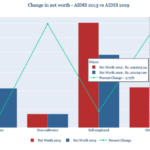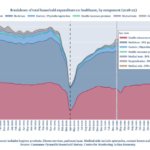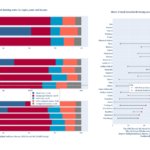Where do Indian households borrow money from?
In this CEDA-CMIE bulletin, we look at the different sources of household borrowings. We examine these patterns for variation by region (urban-vs-rural), state, and household income, and identify how these trends have changed in recent years.
Key highlights
- More than half of all households had borrowed money in some form or the other as of Sep-Dec 2022.
- Rural households are more likely to have borrowed money as compared to their urban counterparts
- Indian households borrow from a range of formal and informal sources, with the most popular form of borrowing being credit from local shops
- There is wide variation in preference for different sources of borrowing money at the state level
Half of all households (50.3 percent) in India had borrowed money in some form or the other (as of Sep-Dec 2022 period), data from the Centre for Monitoring Indian Economy’s Consumer Pyramids Household Survey (CMIE-CPHS) shows. Those living in rural areas were more likely to have borrowed as compared to those living in urban areas during this period. While 54.7 percent of rural households had some form of outstanding credit in Sep-Dec 2022, in urban areas the share of such households was 41.4 percent (Figure 1).
Figure 1
The picture varied widely by state**. Among the larger states of the country, Bihar had the highest share of households with some form of borrowings – 96.2 percent of the households had outstanding credit in the Sep-Dec 2022 period. Uttarakhand came in next with 85.4 percent of households having borrowed money and in Madhya Pradesh, this share was 81.6 percent.
On the other side of the spectrum, in Uttar Pradesh, only 11.7 percent households had borrowed money in some form. Himachal Pradesh and Delhi were next, with 14 and 16.4 percent of households having borrowed in some form or the other.
What are the most common modes of household borrowing?
Indian households borrow in different ways and from a range of sources. While banks and formal financial institutions have penetrated deeper and wider in the country over the years, household borrowing from informal sources remains a common phenomenon.
This reliance on informal sources of credit is not always driven simply by a lack of access to formal institutions, it is also “driven by the advantages of localised sources of credit to households”, Reserve Bank of India’s Household Finance Committee had observed in its report in 2017.
Households borrow from institutions such as banks, and non-banking financial companies (NBFCs); they have also relied on relatives or friends, moneylenders, Self-Help Groups (SHGs), and employers. Several households had outstanding credit in the form of money they owed to local shops, credit card dues etc.
Figure 2
In fact, the most common source for borrowing in the country was in the form of money that households owed to local shops, with nearly a third (30.2 percent) of all households borrowing this way. Banks came in next with 11.9 percent households using this source of borrowing, while 5.7 percent households borrowed from relatives/friends and a similar share borrowed from self-help groups (SHGs).
We explore these common sources in greater detail in the following sections:
Credit from shops
Buying items from local shops on credit (udhar in Hindi, i.e. with a promise to pay later) is a common phenomenon in India, especially for purchasing daily needs such as groceries and food items. Typically, customers purchase items and pay the amount due later, either cumulatively for a certain time period, or when they have enough money to pay back. In their study identifying coping strategies adopted by poor households in urban slums of Delhi to avoid food insecurity, Gupta et al (2015) note that buying food on credit from local private grocery stores is one way in which families try to increase short-term availability of food.
This is an informal credit mechanism and works on trust with shopkeepers extending this option to regular customers, living close-by, whom they can recognise and trust (Gupta et al, 2015).
Figure 3
CMIE-CPHS data indicates that borrowing from shops has increased in recent years. As Figure 3 shows, as of Jan-Apr 2018, only 11 percent of Indian households had borrowed using this source. A year later, almost a quarter of households (24.8 percent) had credit which they owed to local shops. The share of such households fell slightly during 2020 – the first year of the Covid-19 pandemic – but has risen gradually since then.
Rural households are more likely to shop on credit from local shops as compared to their urban counterparts – while 20.9 percent urban households owed money to local shops in Sep-Dec 2022, in rural areas this share was considerably higher at 34.8 percent.
Figure 4
As Figure 4 shows, this form of credit borrowing is more common among the poorer households. While 31.7 percent of households earning INR 1 lakh owed money to local shops in Jan-Apr 2022, the share of such households earning between INR 1-2 lakh was 41.7 percent. However, the share was lower in households with higher incomes, with 11.2 percent of the richest households (those with annual income of INR 10 lakh or more) having outstanding credit from shops.
Among larger states of India, Bihar had the highest share of households (87.9 percent) that had borrowed from a local shop as of the Sep-Dec 2022 period. It was followed by West Bengal where the share of such households was 76.3 percent, and Jharkhand with 73.3 percent households that had taken credit from local shops. In Himachal Pradesh and Delhi on the other hand, no household had outstanding credit from shops in this period, while in Andhra Pradesh only 0.1 percent households had borrowed from this source.
Borrowing from banks
If the share of those with outstanding credit from shops has seen a growth, borrowing formally from banks has, on the other hand, remained largely unchanged since the Jan-Apr 2018 period with about 9-11 percent of households borrowing from banks through the years. An exception was the Sep-Dec 2020 period when the share of those that had borrowed from a bank saw a significant dip, possibly due to Covid-19 induced economic precarity, or even due to the pandemic-related mobility restrictions and social distancing requirements that constrained banking institutions’ capacity to serve the public (see for example this, this, and this news report).
Figure 5
While the proportion of urban and rural households borrowing from banks was the same during Jan-April 2018, a gap started emerging by 2019 when rural households were slightly more likely to have borrowed from a bank than urban ones (Figure 5). This gap has widened since 2020, and as of the Sep-Dec 2022 period, 13.3 percent rural households had borrowed from this source, as compared to 9.3 percent of urban households.
Figure 6
When borrowing from banks is analysed from an income lens (Figure 6), the trends are the opposite of what we saw in Figure 4. Households with higher incomes are more likely to have borrowed from banks as compared to their poorer counterparts, and within richer households, borrowing from banks has been rising after seeing a dip in the Sep-Dec 2020 period. As of the Jan-Apr 2022 period, for example, 30.9 percent of the richest households (with annual incomes exceeding INR 10 lakh) had borrowed from a bank while only 3.7 percent of the poorest households (annual income of INR 1 lakh or less) had done the same.
In Madhya Pradesh, 45.4 percent of households had borrowed money from a bank as of the Sep-Dec 2022 period, the highest among major states in the country. Next was Punjab where 27.6 percent of households had borrowed from this source, followed by Kerala with 26.1 percent households that had borrowed from a bank. On the other end of the spectrum were Bihar, Jharkhand and Andhra Pradesh with 0.5, 1 and 2 percent households that had borrowed money from a bank.
Borrowing from friends and relatives
A small share of households in India (5.7 percent) borrow from friends and family members – however more households fell back on their personal relationships during May-Aug 2020, during the first long and stringent pandemic-induced lockdown. At that time, a tenth of households had borrowed from relatives/friends. The richest households were the least likely to borrow from their acquaintances.
Figure 7
Borrowing from friends and relatives is more common only in a handful of states (see Figure 7)- in Gujarat, 23.1 percent of households had borrowed money from friends/relatives as of the Sep-Dec 2022 period. In Chhattisgarh and Jharkhand, 20.1 and 16.1 percent households had borrowed money through this source respectively, and in Maharashtra, the share of such households was 15.6 percent.
Credit from self-help groups (SHGs)
Similarly, 5.7 percent of households had borrowed from a self-help group (SHG) as of the Sep-Dec 2022 period, with 5.9 percent rural households and 5.4 percent urban households using this source of borrowing.
Figure 8
Borrowing from SHGs appears particularly popular in two states (Figure 8) – Telangana and Andhra Pradesh with 56.8 percent and 45.1 percent households respectively borrowing from one. This is not surprising since these states have had a strong presence of such groups (Deshpande, 2022) Kerala had the third highest share of households that borrowed from an SHG in this period (19.2 percent). In several states, on the other hand, including Uttar Pradesh, Punjab, Jammu and Kashmir, Madhya Pradesh, Delhi, Haryana and Gujarat, no households had borrowed from SHGs as of the Sep-Dec 2022 period.
Households with annual income of INR 2-5 lakh were most likely to borrow from SHGs. In the Jan-Apr 2022 period, 7.5 percent of such households had borrowed from an SHG, as compared to 1.1 percent of households with annual income less than INR 1 lakh, 2.9 percent of households with annual income above INR 10 lakh.
Borrowing from moneylenders
While only a small share (4.4 percent) of households had borrowed from moneylenders in Jan-Apr 2018, that share has only shrunk over time. As of the Sep-Dec 2022 period, only 1.2 percent of households borrowed money from a moneylender in the country. The trends were similar for urban and rural households, and across income groups. It is only in Chhattisgarh that a sizable share of households (29 percent) borrowed from a moneylender as of Sep-Dec 2022. In all other states a very small share of households had borrowed from a moneylender in this period. Chhattisgarh’s high share of households borrowing from money lenders seems to be a recent phenomenon, beginning the Jan-Apr 2021 period.
**Analysis includes data only for 21 large states (and includes data for Delhi)
If you wish to republish this article or use an extract or chart, please read CEDA’s republishing guidelines.
Read past CEDA-CMIE Bulletins here.




